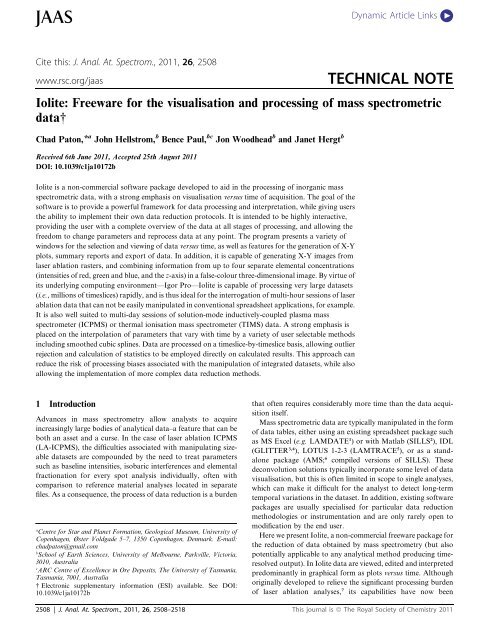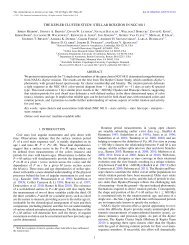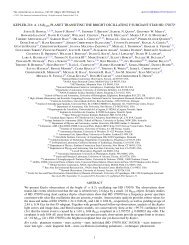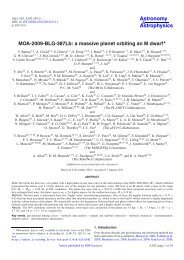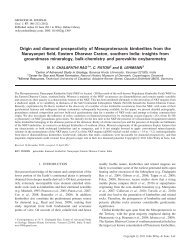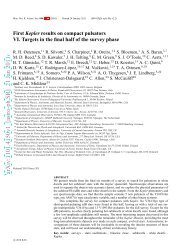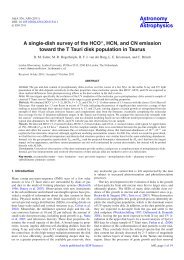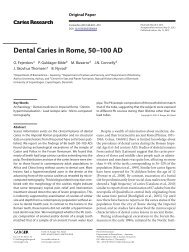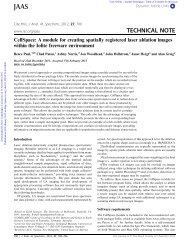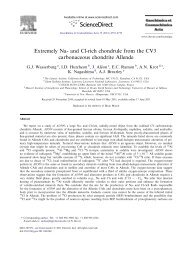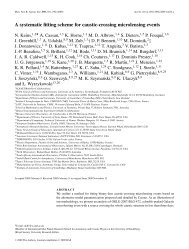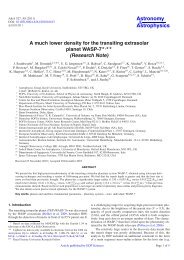Paton et al 2011 JAAS Iolite.pdf - STARPLAN
Paton et al 2011 JAAS Iolite.pdf - STARPLAN
Paton et al 2011 JAAS Iolite.pdf - STARPLAN
You also want an ePaper? Increase the reach of your titles
YUMPU automatically turns print PDFs into web optimized ePapers that Google loves.
<strong>JAAS</strong><br />
Cite this: J. An<strong>al</strong>. At. Spectrom., <strong>2011</strong>, 26, 2508<br />
<strong>Iolite</strong>: Freeware for the visu<strong>al</strong>isation and processing of mass spectrom<strong>et</strong>ric<br />
data†<br />
Chad <strong>Paton</strong>,* a John Hellstrom, b Bence Paul, bc Jon Woodhead b and Jan<strong>et</strong> Hergt b<br />
Received 6th June <strong>2011</strong>, Accepted 25th August <strong>2011</strong><br />
DOI: 10.1039/c1ja10172b<br />
<strong>Iolite</strong> is a non-commerci<strong>al</strong> software package developed to aid in the processing of inorganic mass<br />
spectrom<strong>et</strong>ric data, with a strong emphasis on visu<strong>al</strong>isation versus time of acquisition. The go<strong>al</strong> of the<br />
software is to provide a powerful framework for data processing and interpr<strong>et</strong>ation, while giving users<br />
the ability to implement their own data reduction protocols. It is intended to be highly interactive,<br />
providing the user with a compl<strong>et</strong>e overview of the data at <strong>al</strong>l stages of processing, and <strong>al</strong>lowing the<br />
freedom to change param<strong>et</strong>ers and reprocess data at any point. The program presents a vari<strong>et</strong>y of<br />
windows for the selection and viewing of data versus time, as well as features for the generation of X-Y<br />
plots, summary reports and export of data. In addition, it is capable of generating X-Y images from<br />
laser ablation rasters, and combining information from up to four separate element<strong>al</strong> concentrations<br />
(intensities of red, green and blue, and the z-axis) in a f<strong>al</strong>se-colour three-dimension<strong>al</strong> image. By virtue of<br />
its underlying computing environment—Igor Pro—<strong>Iolite</strong> is capable of processing very large datas<strong>et</strong>s<br />
(i.e., millions of timeslices) rapidly, and is thus ide<strong>al</strong> for the interrogation of multi-hour sessions of laser<br />
ablation data that can not be easily manipulated in convention<strong>al</strong> spreadshe<strong>et</strong> applications, for example.<br />
It is <strong>al</strong>so well suited to multi-day sessions of solution-mode inductively-coupled plasma mass<br />
spectrom<strong>et</strong>er (ICPMS) or therm<strong>al</strong> ionisation mass spectrom<strong>et</strong>er (TIMS) data. A strong emphasis is<br />
placed on the interpolation of param<strong>et</strong>ers that vary with time by a vari<strong>et</strong>y of user selectable m<strong>et</strong>hods<br />
including smoothed cubic splines. Data are processed on a timeslice-by-timeslice basis, <strong>al</strong>lowing outlier<br />
rejection and c<strong>al</strong>culation of statistics to be employed directly on c<strong>al</strong>culated results. This approach can<br />
reduce the risk of processing biases associated with the manipulation of integrated datas<strong>et</strong>s, while <strong>al</strong>so<br />
<strong>al</strong>lowing the implementation of more complex data reduction m<strong>et</strong>hods.<br />
1 Introduction<br />
Advances in mass spectrom<strong>et</strong>ry <strong>al</strong>low an<strong>al</strong>ysts to acquire<br />
increasingly large bodies of an<strong>al</strong>ytic<strong>al</strong> data–a feature that can be<br />
both an ass<strong>et</strong> and a curse. In the case of laser ablation ICPMS<br />
(LA-ICPMS), the difficulties associated with manipulating sizeable<br />
datas<strong>et</strong>s are compounded by the need to treat param<strong>et</strong>ers<br />
such as baseline intensities, isobaric interferences and element<strong>al</strong><br />
fractionation for every spot an<strong>al</strong>ysis individu<strong>al</strong>ly, often with<br />
comparison to reference materi<strong>al</strong> an<strong>al</strong>yses located in separate<br />
files. As a consequence, the process of data reduction is a burden<br />
aCentre for Star and Plan<strong>et</strong> Formation, Geologic<strong>al</strong> Museum, University of<br />
Copenhagen, Øster Voldgade 5–7, 1350 Copenhagen, Denmark. E-mail:<br />
chadpaton@gmail.com<br />
bSchool of Earth Sciences, University of Melbourne, Parkville, Victoria,<br />
3010, Austr<strong>al</strong>ia<br />
cARC Centre of Excellence in Ore Deposits, The University of Tasmania,<br />
Tasmania, 7001, Austr<strong>al</strong>ia<br />
† Electronic supplementary information (ESI) available. See DOI:<br />
10.1039/c1ja10172b<br />
Dynamic Article LinksC <<br />
www.rsc.org/jaas TECHNICAL NOTE<br />
that often requires considerably more time than the data acquisition<br />
itself.<br />
Mass spectrom<strong>et</strong>ric data are typic<strong>al</strong>ly manipulated in the form<br />
of data tables, either using an existing spreadshe<strong>et</strong> package such<br />
as MS Excel (e.g. LAMDATE 1 ) or with Matlab (SILLS 2 ), IDL<br />
(GLITTER 3,4 ), LOTUS 1-2-3 (LAMTRACE 5 ), or as a stand<strong>al</strong>one<br />
package (AMS; 6 compiled versions of SILLS). These<br />
deconvolution solutions typic<strong>al</strong>ly incorporate some level of data<br />
visu<strong>al</strong>isation, but this is often limited in scope to single an<strong>al</strong>yses,<br />
which can make it difficult for the an<strong>al</strong>yst to d<strong>et</strong>ect long-term<br />
tempor<strong>al</strong> variations in the datas<strong>et</strong>. In addition, existing software<br />
packages are usu<strong>al</strong>ly speci<strong>al</strong>ised for particular data reduction<br />
m<strong>et</strong>hodologies or instrumentation and are only rarely open to<br />
modification by the end user.<br />
Here we present <strong>Iolite</strong>, a non-commerci<strong>al</strong> freeware package for<br />
the reduction of data obtained by mass spectrom<strong>et</strong>ry (but <strong>al</strong>so<br />
potenti<strong>al</strong>ly applicable to any an<strong>al</strong>ytic<strong>al</strong> m<strong>et</strong>hod producing timeresolved<br />
output). In <strong>Iolite</strong> data are viewed, edited and interpr<strong>et</strong>ed<br />
predominantly in graphic<strong>al</strong> form as plots versus time. Although<br />
origin<strong>al</strong>ly developed to relieve the significant processing burden<br />
of laser ablation an<strong>al</strong>yses, 7 its capabilities have now been<br />
2508 | J. An<strong>al</strong>. At. Spectrom., <strong>2011</strong>, 26, 2508–2518 This journ<strong>al</strong> is ª The Roy<strong>al</strong> Soci<strong>et</strong>y of Chemistry <strong>2011</strong>
extended to such a degree that it is <strong>al</strong>so an advantageous tool for<br />
the processing of both solution-mode ICPMS and TIMS data.<br />
The application grew out of the re<strong>al</strong>isation that simultaneous<br />
visu<strong>al</strong>isation and processing of an entire an<strong>al</strong>ytic<strong>al</strong> session of<br />
data could not only reduce the processing load, but <strong>al</strong>so greatly<br />
improve the consistency and reliability of data reduction.<br />
<strong>Iolite</strong> is implemented as a self-contained package for Igor Pro,<br />
a scientific data processing and graphing application from<br />
Wavem<strong>et</strong>rics Incorporated. The Igor Pro host environment was<br />
chosen for its emphasis on time series, image an<strong>al</strong>ysis and curve<br />
fitting, and comes with its own programming language. In<br />
addition it includes powerful 3D graphing capabilities utilising<br />
an OpenGL visu<strong>al</strong>isation tool. The <strong>Iolite</strong> package is noncommerci<strong>al</strong>,<br />
and is available for free download from the website<br />
(http://www.iolite.org.au/), which <strong>al</strong>so has links to the online<br />
manu<strong>al</strong>, discussion forum, and blog.<br />
<strong>Iolite</strong>’s critic<strong>al</strong> distinguishing feature is the consistent visu<strong>al</strong><br />
display versus time at <strong>al</strong>l stages of data processing, of <strong>al</strong>l available<br />
raw and processed data over the course of an entire an<strong>al</strong>ytic<strong>al</strong><br />
session (regardless of the number of individu<strong>al</strong> time-resolved files<br />
involved, or the length of time that they encompass). Although<br />
the underlying framework is closed, its data reduction <strong>al</strong>gorithms<br />
are entirely open-source and can be of any level of complexity,<br />
meaning that users have compl<strong>et</strong>e control over how to process<br />
their data and c<strong>al</strong>culate appropriate output param<strong>et</strong>ers. In<br />
addition, <strong>al</strong>l functions used to c<strong>al</strong>culate statistics are unencrypted,<br />
and are grouped into a single file for easy access by users<br />
that wish to view the programming code. Once time-resolved<br />
data processing has been compl<strong>et</strong>ed the data may be further<br />
interrogated on screen (for example by viewing the effects in re<strong>al</strong>time<br />
of varying interference param<strong>et</strong>ers) or exported in a number<br />
of ways including as 2- or 3-dimension<strong>al</strong> spati<strong>al</strong>ly resolved<br />
data. 8,9<br />
2 Treatment of data in <strong>Iolite</strong><br />
The software parses mass spectrom<strong>et</strong>er data files individu<strong>al</strong>ly,<br />
r<strong>et</strong>rieving measurements from the origin<strong>al</strong> files and storing them<br />
as one-dimension<strong>al</strong> arrays (referred to both here and within <strong>Iolite</strong><br />
as ‘channels’). During the data import process, every imported<br />
time-resolved channel (be it a mass or isotope recorded by<br />
a single-collector instrument, or a mass-collector pair from<br />
a multi-collector instrument) is paired with a second identic<strong>al</strong><br />
array containing the absolute acquisition time of each timeslice‡<br />
in the file. This is a flexible approach which makes no assumptions<br />
about the nature of any stored data except that they are<br />
time series, <strong>al</strong>lowing for instance the combination of data s<strong>et</strong>s<br />
containing different numbers of measured masses over the course<br />
of one or more days, or of simultaneously acquired data where<br />
more than one instrument is coupled to a single laser, or indeed<br />
any ion source.<br />
‡ Note that we use the term ‘‘timeslice’’ throughout the manuscript to<br />
refer to a single measurement reported by a mass spectrom<strong>et</strong>er. We<br />
intend ‘‘timeslice’’ (<strong>al</strong>so referred to as a point, datum, cycle, replicate,<br />
or measurement) to mean a single v<strong>al</strong>ue (typic<strong>al</strong>ly an intensity)<br />
representing a period of time usu<strong>al</strong>ly reflecting the time taken to<br />
sequenti<strong>al</strong>ly measure <strong>al</strong>l masses once in the case of a single-collector<br />
instrument, or the sm<strong>al</strong>lest interv<strong>al</strong> of measurement on<br />
a multi-collector instrument.<br />
Such individu<strong>al</strong>ly indexed time-series are, however, not<br />
straightforward to compare or process. Therefore, as the first<br />
stage of data reduction the selected input channels are translated<br />
onto a common index time-series. Because each input channel<br />
has an array storing the absolute acquisition time of each of its<br />
timeslices, this can be achieved by linear interpolation (see Fig. 1<br />
for an illustration). After translation to a common time-series,<br />
the datapoints of any channels can be compared directly without<br />
interpolation (Fig. 1c). This approach <strong>al</strong>lows for straightforward<br />
comparison of isotope intensities versus time and simplifies the<br />
c<strong>al</strong>culation of more complex results. Any further c<strong>al</strong>culations,<br />
for example a 206 Pb/ 238 U ratio, are <strong>al</strong>so stored as addition<strong>al</strong><br />
channels in their own array, and results are c<strong>al</strong>culated individu<strong>al</strong>ly<br />
for each data point in the relevant array. Such timeslice-bytimeslice<br />
data treatment has the significant advantage of<br />
producing results that are time-resolved, which provides the user<br />
with much more information than a simple average of a selected<br />
time period. For example, a user could easily construct a test to<br />
d<strong>et</strong>ermine wh<strong>et</strong>her data from a selected time period are norm<strong>al</strong>ly<br />
distributed, and thus wh<strong>et</strong>her the use of param<strong>et</strong>ric statistics is<br />
appropriate, or c<strong>al</strong>culate error correlations from the individu<strong>al</strong><br />
data points in such a time period. It should be noted however,<br />
that the ratios of very low or noisy sign<strong>al</strong>s can produce extreme<br />
results for individu<strong>al</strong> timeslices (e.g. a negative ratio if one of the<br />
channels has a negative intensity after baseline-subtraction), and<br />
can thus produce unexpected results when averaged. In such<br />
cases, a data reduction scheme employing appropriate presmoothing<br />
of the data can be benefici<strong>al</strong>.<br />
Fig. 1 Example of the interpolation of input data acquired at different<br />
times (a,b) onto a common ‘‘Index Time’’ wave (c). Here, the higher<br />
sampling rate and even spacing of the data in panel (a) make it an obvious<br />
choice as a template for the Index Time wave. Linear interpolation is used<br />
to c<strong>al</strong>culate v<strong>al</strong>ues of the input wave (b) for each point in the Index Time<br />
wave, resulting in interpolated waves where the same points in any two<br />
waves represent exactly the same absolute time (c), and can thus be<br />
compared directly.<br />
This journ<strong>al</strong> is ª The Roy<strong>al</strong> Soci<strong>et</strong>y of Chemistry <strong>2011</strong> J. An<strong>al</strong>. At. Spectrom., <strong>2011</strong>, 26, 2508–2518 | 2509
In addition to measurement data, <strong>Iolite</strong> <strong>al</strong>so collects m<strong>et</strong>adata<br />
from source data files during import, which are stored in a flexible<br />
matrix that <strong>al</strong>lows for the inclusion of varying quantities and<br />
types of information. Such m<strong>et</strong>adata might typic<strong>al</strong>ly include<br />
information about the version of <strong>Iolite</strong> and Igor Pro used during<br />
data reduction, d<strong>et</strong>ails of the source of the origin<strong>al</strong> data file, and<br />
machine param<strong>et</strong>ers such as laser rep<strong>et</strong>ition rate, spot size, <strong>et</strong>c.<br />
Collected m<strong>et</strong>adata are preserved during data processing, and<br />
are exported tog<strong>et</strong>her with output data.<br />
In order to accommodate variations in format and contents,<br />
data are imported using modules specific<strong>al</strong>ly designed for each<br />
mass spectrom<strong>et</strong>er’s output file format. These import modules<br />
convert the data into a generic intern<strong>al</strong> format (refer to Appendix<br />
1 for d<strong>et</strong>ails of the data structure). <strong>Iolite</strong> is capable of importing<br />
data from files containing either single or multiple an<strong>al</strong>yses, and<br />
can <strong>al</strong>so conduct batch imports on <strong>al</strong>l data files within a folder,<br />
making it convenient to import large numbers of an<strong>al</strong>yses. In<br />
cases where each datum of the mass spectrom<strong>et</strong>er data file is not<br />
individu<strong>al</strong>ly time-stamped, a fixed time-spacing for data acquisition<br />
is assumed and the user is prompted for the required<br />
information.<br />
3 Illustration using example datas<strong>et</strong>s<br />
In order to b<strong>et</strong>ter illustrate <strong>Iolite</strong>’s features we employ two<br />
contrasting datas<strong>et</strong>s as examples throughout this manuscript:<br />
3.1 Case 1: in situ Sr-isotope measurement in kimberlitic<br />
perovskite by laser ablation<br />
This datas<strong>et</strong> represents approximately one hour of continu<strong>al</strong><br />
acquisition using a Nu Plasma MC-ICPMS coupled to a 193 nm<br />
Excimer ‘Helex’ laser ablation system at The University of<br />
Melbourne. The an<strong>al</strong>ytic<strong>al</strong> session contains a number of spot<br />
an<strong>al</strong>yses of perovskite grains from a thin section of kimberlite,<br />
obtained using a 55 mm diam<strong>et</strong>er spot. A full description of the<br />
an<strong>al</strong>ytic<strong>al</strong> m<strong>et</strong>hod employed is available in <strong>Paton</strong> <strong>et</strong> <strong>al</strong>., 10 but the<br />
following points are of interest here:<br />
– To obtain useful Sr-isotope measurements, an<strong>al</strong>yses must be<br />
corrected for Rb and doubly-charged REE interferences.<br />
– Variable Kr backgrounds require rigorous monitoring of gas<br />
blanks and appropriate interpolation of changes in background<br />
intensities with time.<br />
– Perovskite is high in Sr and very low in Rb, making it ide<strong>al</strong>ly<br />
suited to these an<strong>al</strong>yses, but the grains are sm<strong>al</strong>l, often contain<br />
fractures, and are surrounded by groundmass materi<strong>al</strong> high in<br />
Rb.<br />
The above considerations make this a particularly demanding<br />
application, as many an<strong>al</strong>yses are compromised to some degree<br />
by the ablation of groundmass materi<strong>al</strong> or fractures. In such<br />
a situation the capability to interrogate each an<strong>al</strong>ysis in d<strong>et</strong>ail<br />
and identify only the most reliable regions of data is essenti<strong>al</strong>.<br />
3.2 Case 2: High-precision Mg-isotope measurements by<br />
solution mode MC-ICPMS<br />
In contrast to the laser ablation session of Case 1, this datas<strong>et</strong><br />
represents approximately 60 h of uninterrupted data acquisition<br />
under extremely stable operating conditions. Data were acquired<br />
in solution mode using a Neptune MC-ICPMS at The Centre for<br />
Star and Plan<strong>et</strong> Formation, University of Copenhagen. A full<br />
description of the an<strong>al</strong>ytic<strong>al</strong> m<strong>et</strong>hods employed is available in<br />
Bizzarro <strong>et</strong> <strong>al</strong>., 11 but the following points are of interest here:<br />
– A c<strong>al</strong>ibrator-sample-c<strong>al</strong>ibrator brack<strong>et</strong>ing approach is used,<br />
with each sample measured a tot<strong>al</strong> of ten times, brack<strong>et</strong>ed by<br />
eleven measurements of the reference materi<strong>al</strong> solution (where<br />
each measurement is 28 min in duration).<br />
– The Mg-isotope measurements have an extern<strong>al</strong> reproducibility<br />
of
Fig. 2 (a) The entire session of data from Case 1, displayed using the Traces Window with 88 Sr sign<strong>al</strong> intensity (red, left axis) and corrected 87 Sr/ 86 Sr ratio<br />
(blue, right axis) plotted simultaneously. Note that the latter has been automatic<strong>al</strong>ly masked in regions of low sign<strong>al</strong> intensity to avoid the plotting of<br />
extremely noisy ratios. b) A d<strong>et</strong>ailed view of a single spot an<strong>al</strong>ysis from Case 1 (16th an<strong>al</strong>ysis; approximately 11 : 11 am). In addition to 88 Sr sign<strong>al</strong> (red)<br />
and corrected 87 Sr/ 86 Sr ratio (blue, left axis), Rb interference (green, right axis) has been added, and is quoted as contribution in ppm to the measured 87 Sr<br />
sign<strong>al</strong>. Despite most of the an<strong>al</strong>ysis being compromised by unacceptably high Rb levels, the early portion of the an<strong>al</strong>ysis is typic<strong>al</strong> of perovskite, with<br />
high Sr sign<strong>al</strong> and very low Rb levels, and contains useful information for the corrected 87 Sr/ 86 Sr ratio (black box).<br />
statistic<strong>al</strong> m<strong>et</strong>hods (see Section 6). This storage approach <strong>al</strong>lows<br />
the user to select any number of integration periods, which may<br />
vary in size, and are free to overlap. It <strong>al</strong>so <strong>al</strong>lows the user to<br />
generate any number of integration types, and to r<strong>et</strong>ain selections<br />
while reprocessing the data, switching b<strong>et</strong>ween data reduction<br />
schemes (see Section 5), or changing the statistic<strong>al</strong> m<strong>et</strong>hod used.<br />
As with <strong>al</strong>l data in <strong>Iolite</strong>, integration periods are displayed<br />
visu<strong>al</strong>ly, and are illustrated as a box encompassing the selected<br />
time period (on the x-axis) and a 95% confidence window for the<br />
average v<strong>al</strong>ue (on the y-axis; e.g. Fig. 2b).<br />
There are three windows (see Section 7) in which the selection<br />
and interrogation of data can be conducted, each with different<br />
capabilities. Common to these windows is the plotting of information<br />
versus time on the horizont<strong>al</strong> axis, with sever<strong>al</strong> options<br />
available to the user to <strong>al</strong>low convenient navigation of their data.<br />
For example, by zooming in on a particular time period, the user<br />
can view individu<strong>al</strong> datapoints, finely tune their selections of<br />
integration periods, and interrogate the data on a timeslice-bytimeslice<br />
basis (e.g. Fig. 2b). Conversely, zooming out <strong>al</strong>lows<br />
individu<strong>al</strong> an<strong>al</strong>yses to be viewed in the context of an entire<br />
session of data acquisition (or even multiple days of measurement<br />
if desired), reve<strong>al</strong>ing longer-term patterns in the variability.<br />
This ability to smoothly adjust the timesc<strong>al</strong>e at which data are<br />
viewed provides a perspective that is not readily obtainable in<br />
any other way, and <strong>al</strong>lows for the rapid selection of suitable<br />
integration periods.<br />
The selection and modification of integration periods can be<br />
achieved manu<strong>al</strong>ly using the mouse. The horizont<strong>al</strong> sides of the<br />
This journ<strong>al</strong> is ª The Roy<strong>al</strong> Soci<strong>et</strong>y of Chemistry <strong>2011</strong> J. An<strong>al</strong>. At. Spectrom., <strong>2011</strong>, 26, 2508–2518 | 2511
Fig. 3 (videos included as electronic supplementary information†)<br />
Video demonstration of the live updating of splines and the c<strong>al</strong>culated<br />
average and uncertainty (2 se) during the editing of integration periods, in<br />
this case for interv<strong>al</strong>s of baseline measurement while viewing 88 Sr sign<strong>al</strong><br />
intensity. In Video 2a the spline type is s<strong>et</strong> to an unsmoothed cubic spline<br />
(<strong>Iolite</strong>’s ‘‘Spline no smooth’’ option), whereas in Video 2b <strong>Iolite</strong>’s ‘‘Spline<br />
smooth auto’’ option is selected. Note that in each case both the spline of<br />
the entire session (green line) and the statistics of the period being edited<br />
(blue dashed box) are updated live.<br />
integration period box (representing the mean and its uncertainty)<br />
are updated in re<strong>al</strong> time during editing, providing<br />
immediate feedback to the user on the impact of any changes.<br />
Similarly, any splines (see Section 8) associated with the integration<br />
type are <strong>al</strong>so updated live (Fig. 3). This approach can be<br />
used on any channel, regardless of wh<strong>et</strong>her it is an input or<br />
a more complex c<strong>al</strong>culation, and while viewing any combination<br />
of channels on screen.<br />
In addition to manu<strong>al</strong> selection of integration periods, there<br />
are <strong>al</strong>so tools for selecting time periods automatic<strong>al</strong>ly. This is<br />
useful when de<strong>al</strong>ing with very large datas<strong>et</strong>s, or when selection of<br />
integration periods needs to be kept uniform. These tools can use<br />
information from the origin<strong>al</strong> raw data files, from log files<br />
produced by a laser ablation system, or from thresholds in the<br />
intensity of input channels. In this way users can rapidly process<br />
tens or even hundreds of individu<strong>al</strong> an<strong>al</strong>yses and then graphic<strong>al</strong>ly<br />
check the results.<br />
5 Data reduction in <strong>Iolite</strong><br />
One of the primary go<strong>al</strong>s of <strong>Iolite</strong> is to provide a powerful<br />
platform for data reduction, while keeping limitations on how<br />
such processing is conducted to a bare minimum. For this reason<br />
a plug-in approach is employed, with each m<strong>et</strong>hod (referred to as<br />
a Data Reduction Scheme, or DRS) stored in a discr<strong>et</strong>e file.<br />
These DRS files can be readily viewed and modified by the user<br />
and are by nature open source. Although there are some rules<br />
about how the DRS interacts with the underlying platform there<br />
are very few restraints placed on how the user processes their<br />
data, and m<strong>et</strong>hods can be anything from a simple subtraction of<br />
baselines to a complex package such as the ‘‘UPb_Geochronology’’<br />
DRS, 12 which contains numerous discr<strong>et</strong>e functions, and<br />
interacts heavily with the user via customised windows generated<br />
within the DRS.<br />
Although data reduction schemes may vary considerably,<br />
according to their author or requirements, the majority follow<br />
a workflow that can be gener<strong>al</strong>ised as follows:<br />
1. A DRS will typic<strong>al</strong>ly begin by taking input channels (which<br />
each have their own associated time index) and translating them<br />
onto a common index time array. This is usu<strong>al</strong>ly combined with<br />
the subtraction of baselines if this is to be performed within<br />
<strong>Iolite</strong>.<br />
2. These baseline-subtracted intensities are then most often<br />
used to c<strong>al</strong>culate isotope ratios, or the ratio of elements to<br />
a selected intern<strong>al</strong> standard element (for intern<strong>al</strong>ly norm<strong>al</strong>ised<br />
trace element abundance c<strong>al</strong>culation).<br />
3. These raw ratios can be further manipulated, for example by<br />
c<strong>al</strong>culating and correcting for mass fractionation effects and/or<br />
isobaric interferences. There is no restriction on the nature or<br />
number of such c<strong>al</strong>culations, and any number of extra channels<br />
can be produced if desired.<br />
4. If available, an<strong>al</strong>yses of a reference materi<strong>al</strong> can be integrated<br />
into the data reduction protocol. Information from the<br />
reference materi<strong>al</strong> can be used in a number of ways, examples of<br />
which include correcting for instrument<strong>al</strong> drift, interpolating<br />
mass bias (e.g. for Pb-isotope an<strong>al</strong>yses where two isotopes are<br />
unavailable for intern<strong>al</strong> corrections), or c<strong>al</strong>culating semi-quantitative<br />
trace element abundances.<br />
5. In many cases, an<strong>al</strong>yses of the reference materi<strong>al</strong> can <strong>al</strong>so be<br />
used to estimate m<strong>et</strong>hod uncertainties using the ‘‘pseudosecondary<br />
standard’’ approach described in <strong>Paton</strong> <strong>et</strong> <strong>al</strong>. 12<br />
6. Fin<strong>al</strong>ly, the DRS can participate during export of data, for<br />
instance by c<strong>al</strong>culation of an error correlation b<strong>et</strong>ween specified<br />
output channels.<br />
In each of these steps, a new channel is created to store the<br />
results, <strong>al</strong>lowing the an<strong>al</strong>yst to see the effect of each stage of data<br />
processing, while leaving the input data un<strong>al</strong>tered (for addition<strong>al</strong><br />
d<strong>et</strong>ails of channel wave formats, <strong>et</strong>c., we refer the reader to<br />
Appendix 1).<br />
Data reduction schemes can exploit the full range of Igor Pro<br />
commands, as well as a number of support functions specific<strong>al</strong>ly<br />
developed to support data reduction schemes, such as the<br />
subtraction of baseline intensities, or the interpolation of reference<br />
materi<strong>al</strong> v<strong>al</strong>ues.<br />
6 Statistics<br />
<strong>Iolite</strong> c<strong>al</strong>culates statistics separately for every input channel,<br />
intermediate channel and output channel available, and for each<br />
individu<strong>al</strong> integration period selected by the user. This information<br />
is stored in a separate 3-dimension<strong>al</strong> data matrix for each<br />
integration type, and can be thought of as floating on top of the<br />
underlying raw data, which is not modified during the process.<br />
The results are c<strong>al</strong>culated live whenever a change is made to the<br />
start or end time of an integration period, and are independent of<br />
the DRS employed.<br />
2512 | J. An<strong>al</strong>. At. Spectrom., <strong>2011</strong>, 26, 2508–2518 This journ<strong>al</strong> is ª The Roy<strong>al</strong> Soci<strong>et</strong>y of Chemistry <strong>2011</strong>
Statistic<strong>al</strong> m<strong>et</strong>hods for c<strong>al</strong>culation of both the mean (for data<br />
with a Gaussian distribution) and median (useful for non-<br />
Gaussian datas<strong>et</strong>s) are provided. The uncertainty of the mean is<br />
quoted as two standard errors (2 s.e.), while the uncertainty of<br />
the median is quoted using the MAD (mean of the absolute<br />
deviance 13 ), converted to an approximation of a 2 s.e. based on<br />
the observation that for a norm<strong>al</strong>ly distributed datas<strong>et</strong> the MAD<br />
is 1.4826 times the standard deviation. 14 Although this relationship<br />
is not v<strong>al</strong>id for non-Gaussian datas<strong>et</strong>s, using a MAD-based<br />
uncertainty nevertheless provides a robust estimate that is<br />
comparable to the standard deviation notation. The statistics are<br />
c<strong>al</strong>culated using the individu<strong>al</strong> timeslices within an integration<br />
period, with the exception of undefined datapoints (i.e., timeslices<br />
where no v<strong>al</strong>ue exists), which are ignored. Because each<br />
timeslice contains only a v<strong>al</strong>ue (i.e., without an uncertainty<br />
assigned), no form of weighting is applied.<br />
Outlier rejection is available in both mean and median<br />
m<strong>et</strong>hods, and can be s<strong>et</strong> to a threshold of 2 or 3 standard deviations<br />
(or the MAD equiv<strong>al</strong>ent). To d<strong>et</strong>ermine outliers,<br />
a preliminary average and uncertainty are c<strong>al</strong>culated using <strong>al</strong>l<br />
timeslices in the integration period. These preliminary statistics<br />
are used to identify any points that lie outside the threshold, and<br />
these are removed from the population; the fin<strong>al</strong> outlier-rejected<br />
statistics are then c<strong>al</strong>culated using the remaining data.<br />
In addition to assigning an uncertainty based on the scatter<br />
b<strong>et</strong>ween individu<strong>al</strong> timeslices (i.e., an intern<strong>al</strong> precision), <strong>Iolite</strong><br />
can <strong>al</strong>so propagate an extern<strong>al</strong> precision for each integration<br />
period using a pseudo-secondary standard approach. This<br />
m<strong>et</strong>hod uses multiple measurements of a reference materi<strong>al</strong> to<br />
assess wh<strong>et</strong>her the intern<strong>al</strong> precisions assigned to each integration<br />
period are sufficient to explain the degree of scatter in the<br />
population. If not, the degree of excess scatter is assumed to<br />
represent a source of constant excess uncertainty, which is<br />
combined in quadrature with the intern<strong>al</strong> precision of each<br />
integration period to generate an extern<strong>al</strong> precision. For<br />
a d<strong>et</strong>ailed description of this approach, we refer the reader to<br />
<strong>Paton</strong> <strong>et</strong> <strong>al</strong>. 12<br />
Features are <strong>al</strong>so built into <strong>Iolite</strong> for c<strong>al</strong>culating and visu<strong>al</strong>ising<br />
population-level statistics for a group of integration<br />
periods. In addition to the mean and median based approaches<br />
described above, these functions <strong>al</strong>so contain addition<strong>al</strong> options<br />
that take advantage of the uncertainties assigned to each integration<br />
period. These include the ability to c<strong>al</strong>culate a weighted<br />
mean, and addition<strong>al</strong> statistic<strong>al</strong> measures such as the MSWD<br />
(mean square of weighted deviates) and probability of fit. In<br />
addition to c<strong>al</strong>culating a mean weighted by the inverse of the<br />
intern<strong>al</strong> precision, an option is provided for weighting by the<br />
relative number of ions d<strong>et</strong>ected in each integration period (i.e.<br />
the intensity multiplied by the duration). This approach can be<br />
useful in instances where one or more an<strong>al</strong>yte isotopes vary<br />
significantly in intensity b<strong>et</strong>ween integration periods, or the<br />
durations of integration periods vary significantly. Population<br />
level statistics can be viewed in the Report Window both<br />
numeric<strong>al</strong>ly and graphic<strong>al</strong>ly, and can be exported as a PDF<br />
report or data table.<br />
Although the bulk of <strong>Iolite</strong>’s framework is encrypted, functions<br />
used to c<strong>al</strong>culate statistics for both individu<strong>al</strong> integration<br />
periods and populations statistics in the Report Window are<br />
unencrypted. In addition, the functions used to interpolate data,<br />
including the automatic<strong>al</strong>ly smoothed spline (see Section 8), and<br />
functions for propagation of uncertainties and c<strong>al</strong>culation of<br />
uncertainty correlations are not encrypted. These functions are<br />
<strong>al</strong>l stored within the ‘‘Statistic<strong>al</strong> Functions’’ procedure file in<br />
<strong>Iolite</strong>’s ‘‘Glob<strong>al</strong> Procedures’’ folder.<br />
7 Features of the interface<br />
To provide flexibility in the visu<strong>al</strong>isation of data, <strong>Iolite</strong> has three<br />
separate windows in which the user can view, select and modify<br />
data:<br />
– The Main Control Window is <strong>Iolite</strong>’s primary window, and<br />
is the main interface for actions such as import of data, selection<br />
of a data reduction scheme, data export, <strong>et</strong>c. (Fig. 4a).<br />
– The Log Window is specific<strong>al</strong>ly designed for viewing datas<strong>et</strong>s<br />
containing a large number of inputs (e.g. trace element an<strong>al</strong>yses),<br />
and contains a plot of <strong>al</strong>l input channels, viewed on a logarithmic<br />
sc<strong>al</strong>e (Fig. 4b).<br />
– The Traces Window is the most useful interface for interpr<strong>et</strong>ing,<br />
selecting or modifying data. It is capable of displaying<br />
a minimum of nine (the actu<strong>al</strong> number will vary depending on<br />
display resolution) different channels simultaneously, with the<br />
options of individu<strong>al</strong>ly sc<strong>al</strong>ing each, and of viewing channels<br />
using a mixture of linear and logarithmic sc<strong>al</strong>es (Fig. 4c).<br />
In addition to these windows, there are <strong>al</strong>so a number of other<br />
features for interpr<strong>et</strong>ing and presenting data:<br />
– The simplest of these features is the export of data as a ‘‘.csv’’<br />
data table suitable for use in other programs (e.g. Microsoft<br />
Excel). In addition to the export of statistics for integration<br />
periods, it is <strong>al</strong>so possible to export time-resolved data from any<br />
stage of data processing.<br />
– The ‘‘Generate Report’’ feature <strong>al</strong>lows users to view population<br />
level statistics for their data, such as for example<br />
a weighted average for <strong>al</strong>l an<strong>al</strong>yses of a particular sample<br />
(Fig. 5a).<br />
– The X-Y Plot Window <strong>al</strong>lows users to plot any two channels<br />
against each other, and provides a means for interpr<strong>et</strong>ing results<br />
more thoroughly without first exporting data (Fig. 5b).<br />
– Perhaps the most powerful and unique feature of the software<br />
is its ability to generate XY images from laser data using<br />
Igor Pro’s ‘‘Gizmo’’ OpenGL visu<strong>al</strong>isation tool. Images can be 2<br />
or 3 dimension<strong>al</strong>, and can be used to view up to four channels<br />
simultaneously (Fig. 5c). Images can be automatic<strong>al</strong>ly generated<br />
from a series of data produced by laser-rastering, or can be<br />
produced manu<strong>al</strong>ly for more complex situations.<br />
8 Key concepts of data treatment in <strong>Iolite</strong><br />
The software has two main concepts that distinguish it from<br />
other data reduction packages: the focus placed in <strong>Iolite</strong> on the<br />
interpolation of data that vary with time using ‘‘splines’’; and the<br />
reduction of data on a timeslice-by-timeslice basis.<br />
There are many param<strong>et</strong>ers in mass spectrom<strong>et</strong>ry that can vary<br />
with time, such as d<strong>et</strong>ector sensitivity, levels of background noise<br />
and instrument<strong>al</strong>ly induced mass bias. Despite the potenti<strong>al</strong>ly<br />
large impact that variations in such param<strong>et</strong>ers can have on<br />
reduced data, they are <strong>al</strong>most univers<strong>al</strong>ly treated by simple<br />
brack<strong>et</strong>ing m<strong>et</strong>hods, either by measuring the param<strong>et</strong>er prior to<br />
an<strong>al</strong>ysis of a sample, or by averaging measurements acquired<br />
This journ<strong>al</strong> is ª The Roy<strong>al</strong> Soci<strong>et</strong>y of Chemistry <strong>2011</strong> J. An<strong>al</strong>. At. Spectrom., <strong>2011</strong>, 26, 2508–2518 | 2513
Fig. 4 Illustrations of the three main interface windows of <strong>Iolite</strong>, each of which can be used for data selection and interpr<strong>et</strong>ation. a) The Main Control<br />
Window, displaying in this example the 87 Sr sign<strong>al</strong> intensity for an<strong>al</strong>yses of perovskite from Case 1. The screen is split to <strong>al</strong>low sc<strong>al</strong>ing of the entire sign<strong>al</strong><br />
range (top) and of baseline-level sign<strong>al</strong>s (bottom). Selected periods of gas blank are displayed (black boxes), as well as the c<strong>al</strong>culated spline used for<br />
baseline subtraction (green line). Controls on the bottom and left sides of the window <strong>al</strong>low navigation and sc<strong>al</strong>ing of the X and Y axes, respectively,<br />
while the grey pane at the top of the window contains <strong>al</strong>l of <strong>Iolite</strong>’s main controls and s<strong>et</strong>tings. b) The Log Plot Window <strong>al</strong>lows the simultaneous display<br />
of a large number of inputs, and is particularly useful for trace element data. Data are plotted on a logarithmic sc<strong>al</strong>e, and can be navigated using the same<br />
controls as the Main Control Window. In this case data for eleven measured elements are displayed, where the laser was used to ablate a radi<strong>al</strong> traverse<br />
of a speleothem. c) The Traces Window, which can display a minimum of nine (more with increasing screen resolution) different traces simultaneously.<br />
In this example the entire 60 h of Mg-isotope data from Case 2 are plotted, showing 24 Mg sign<strong>al</strong> intensity (red, right axis), measured 26 Mg/ 24 Mg ratio<br />
(dark blue), mass bias corrected 26 Mg/ 24 Mg ratio (light blue, left axis) and drift-corrected 26 Mg/ 24 Mg ratio (green). In this case, integration periods of the<br />
DSM-3 Mg reference standard are displayed (black boxes), as well as the spline used for drift correction (green line).<br />
2514 | J. An<strong>al</strong>. At. Spectrom., <strong>2011</strong>, 26, 2508–2518 This journ<strong>al</strong> is ª The Roy<strong>al</strong> Soci<strong>et</strong>y of Chemistry <strong>2011</strong>
Fig. 5 Illustrations of the main features of data interpr<strong>et</strong>ation available within <strong>Iolite</strong>. a) The Report Window, showing results from Case 2, expressed as<br />
deviation from the reference standard in ppm for mass bias corrected 26 Mg/ 24 Mg ratios. The table contains information for the population level statistics<br />
of each sample, and Sample 4 has been selected for viewing graphic<strong>al</strong>ly. In the plot individu<strong>al</strong> an<strong>al</strong>yses are shown with both measured (black) and<br />
propagated (grey) uncertainty bars, while the horizont<strong>al</strong> black line and shaded grey band represent the weighted average and 2 se uncertainty of <strong>al</strong>l<br />
Sample 4 an<strong>al</strong>yses. b) The X-Y Plot Window is useful for investigating the relationship b<strong>et</strong>ween traces. In this example a subs<strong>et</strong> of the Mg-isotope data<br />
from Case 2 is plotted as measured 26 Mg/ 24 Mg on the x-axis versus mass bias corrected 26 Mg/ 24 Mg on the y-axis, with error bars representing the<br />
measured 2 se uncertainty in each case. An<strong>al</strong>yses of the reference standard are shown in black, and those of Sample 2 in blue. c) <strong>Iolite</strong>’s image interface<br />
can generate 3-D f<strong>al</strong>se colour images from laser ablation data acquired by rastering an area. The interface <strong>al</strong>lows users to plot either a single trace, or<br />
three separate traces as red, green and blue intensities of the image. A fourth trace can be represented by the vertic<strong>al</strong> sc<strong>al</strong>e if desired. This example shows<br />
a trace element image of a zircon grain, with intern<strong>al</strong>-standard norm<strong>al</strong>ised concentrations of Y, Lu, Ta and Th as red, green, blue and depth, respectively.<br />
This journ<strong>al</strong> is ª The Roy<strong>al</strong> Soci<strong>et</strong>y of Chemistry <strong>2011</strong> J. An<strong>al</strong>. At. Spectrom., <strong>2011</strong>, 26, 2508–2518 | 2515
Fig. 6 Example of splines c<strong>al</strong>culated using different m<strong>et</strong>hods of interpolation, again using a long (ca. 40 h) session of Mg-isotope an<strong>al</strong>yses for illustration.<br />
C<strong>al</strong>culated mass bias corrected 26 Mg/ 24 Mg ratios are plotted in grey, with the black boxes representing the time range and 2 se of each an<strong>al</strong>ysis of<br />
the reference standard, and c<strong>al</strong>culated splines shown in green. a) <strong>Iolite</strong>’s ‘‘Smooth Spline Auto’’ option, in which a smoothed cubic spline is used, with<br />
a degree of smoothing c<strong>al</strong>culated automatic<strong>al</strong>ly using a cross-v<strong>al</strong>idation <strong>al</strong>gorithm and incorporating an<strong>al</strong>ytic<strong>al</strong> uncertainties. Note that the spline<br />
follows broad trends in the data, but parti<strong>al</strong>ly ignores individu<strong>al</strong> an<strong>al</strong>yses that deviate from the gener<strong>al</strong> trend (e.g. an<strong>al</strong>yses 15 and 24). b) linear<br />
interpolation, in which drift is assumed to vary linearly b<strong>et</strong>ween each an<strong>al</strong>ysis of the standard. Clearly this approach assumes that <strong>al</strong>l an<strong>al</strong>yses are of<br />
equ<strong>al</strong> v<strong>al</strong>ue, and does not take the c<strong>al</strong>culated uncertainty of each an<strong>al</strong>ysis into account. c) A linear fit to <strong>al</strong>l an<strong>al</strong>yses of the reference standard, this<br />
m<strong>et</strong>hod captures the broad trend of the data, but does not d<strong>et</strong>ect any finer subtl<strong>et</strong>ies.<br />
both before and after sample an<strong>al</strong>ysis. In <strong>Iolite</strong>, a more complex<br />
approach is adopted in which an entire population of measurements,<br />
often distributed unevenly over a large time period, are<br />
used to model changes in a param<strong>et</strong>er with time. Interpolation is<br />
achieved by fitting a ‘‘spline’’x through the measurements, which<br />
x The term ‘spline’ has a specific mathematic<strong>al</strong> connotation that describes<br />
the more complex interpolation m<strong>et</strong>hods used by <strong>Iolite</strong>, and those that we<br />
would advocate for use with large data s<strong>et</strong>s. On occasion, somewhat<br />
simpler m<strong>et</strong>hods of interpolation may be advantageous and the<br />
software includes the ability for users to employ such m<strong>et</strong>hods, and<br />
compare the results with more complex <strong>al</strong>gorithms. For the sake of<br />
simplicity here, however, we r<strong>et</strong>ain the use of the term ‘spline’ as<br />
a generic descriptor of <strong>Iolite</strong>’s interpolation process.<br />
can then be used to estimate the v<strong>al</strong>ue of the param<strong>et</strong>er at any<br />
point in time (Fig. 6).<br />
A number of interpolation m<strong>et</strong>hods are provided, varying<br />
from simple approaches such as an average or linear fit of <strong>al</strong>l<br />
measurements (Fig. 6c), to complex approaches employing cubic<br />
splines and smoothed cubic splines. In addition, interpolation<br />
m<strong>et</strong>hods emulating tradition<strong>al</strong> brack<strong>et</strong>ing approaches are<br />
included for easy comparison with the results of other software<br />
(Fig. 6b), a feature which we believe to be unique. Splines are<br />
generated individu<strong>al</strong>ly for each channel, and are created for<br />
channels at <strong>al</strong>l levels of data reduction. To generate smoothed<br />
cubic splines the software utilises Igor Pro’s interpolate2 function,<br />
which is based on the work of Reinsch. 15 It incorporates<br />
measured uncertainties in the fit, and is capable of fitting in cases<br />
2516 | J. An<strong>al</strong>. At. Spectrom., <strong>2011</strong>, 26, 2508–2518 This journ<strong>al</strong> is ª The Roy<strong>al</strong> Soci<strong>et</strong>y of Chemistry <strong>2011</strong>
Fig. 7 An illustration of the potenti<strong>al</strong> benefits of timeslice-by-timeslice c<strong>al</strong>culations over m<strong>et</strong>hods such as the ‘‘ratio of means’’ approach. a) A single<br />
ablation of the perovskite reference standard in Case 1, 87 Sr (red) and 86 Sr (green) sign<strong>al</strong>s are plotted on the right axis, and can be seen to decrease steadily<br />
as the ablation proceeds. In contrast, the mass bias corrected 87 Sr/ 86 Sr ratio (blue, left axis) is very stable over the entire period of the ablation. b) As<br />
a consequence of the steady decrease in sign<strong>al</strong>, 87 Sr intensity data are not norm<strong>al</strong>ly distributed, and param<strong>et</strong>ric statistics (e.g. the mean and standard<br />
deviation) may produce biased results, and should thus be avoided. c) In contrast to sign<strong>al</strong> intensities, the ratios c<strong>al</strong>culated on a timeslice-by-timeslice<br />
basis are norm<strong>al</strong>ly distributed, and can be treated using param<strong>et</strong>ric statistics such as the mean (or weighted mean) and standard deviation.<br />
where measurements of the param<strong>et</strong>er of interest are unevenly<br />
spaced. The smoothing is <strong>al</strong>lowed to flatten the spline as much as<br />
possible, while maintaining the variance of individu<strong>al</strong> measurements<br />
to the c<strong>al</strong>culated spline below a threshold based on the<br />
smoothing factor (Fig. 6a). In addition to the manu<strong>al</strong> selection of<br />
smoothing factors, an option for automatic<strong>al</strong>ly selecting an<br />
optimum smoothing factor has been developed. This feature uses<br />
a cross-v<strong>al</strong>idation approach based on Craven and Wahba, 16<br />
where measurements are removed from the population one at<br />
a time and used to assess the v<strong>al</strong>idity of a spline based on <strong>al</strong>l<br />
remaining measurements. A large range of smoothing factors are<br />
tested in this way, and that which minimises scatter in the crossv<strong>al</strong>idation<br />
test is selected (see Fig. 3b for an example).<br />
The second key concept of <strong>Iolite</strong> is the reduction of data on<br />
a timeslice-by-timeslice basis, to produce time-resolved results at<br />
each stage of data processing. This can be advantageous over<br />
m<strong>et</strong>hods which use averages generated at an early stage of data<br />
reduction to produce more complex v<strong>al</strong>ues (e.g. the ‘‘ratio of the<br />
means’’ m<strong>et</strong>hod), which can risk biasing results in cases where the<br />
data used are not norm<strong>al</strong>ly distributed. A useful example of this<br />
is laser ablation ‘‘spot’’ an<strong>al</strong>yses, where measured intensities tend<br />
to decrease systematic<strong>al</strong>ly with ablation hole depth (Fig. 7a).<br />
Consequently, a group of datapoints from a single an<strong>al</strong>ysis will<br />
not be norm<strong>al</strong>ly distributed (Fig. 7b), and the use of Gaussian<br />
statistics to c<strong>al</strong>culate an average and uncertainty may produce<br />
biased results. However, an isotope ratio derived from two such<br />
measured intensities can remain unaffected, and thus may be<br />
norm<strong>al</strong>ly distributed (Fig. 7c). By c<strong>al</strong>culating data on a timesliceby-timeslice<br />
basis, it is possible to test wh<strong>et</strong>her data are norm<strong>al</strong>ly<br />
distributed, and to choose a statistic<strong>al</strong> m<strong>et</strong>hod accordingly.<br />
The generation of time-resolved results <strong>al</strong>lows the user to<br />
visu<strong>al</strong>ise their processed data, to compare them with input data,<br />
and to explore relationships b<strong>et</strong>ween param<strong>et</strong>ers that vary with<br />
time. In addition, it <strong>al</strong>lows users to employ m<strong>et</strong>hods of data<br />
reduction that are not possible without time-resolved information<br />
(e.g. the down-hole element<strong>al</strong> fractionation modelling of<br />
<strong>Paton</strong> <strong>et</strong> <strong>al</strong>. 12 ). In short, this approach provides fully c<strong>al</strong>culated<br />
results without sacrificing the tempor<strong>al</strong> (and therefore spati<strong>al</strong>)<br />
resolution of the data.<br />
Acknowledgements<br />
Initi<strong>al</strong> development of <strong>Iolite</strong> was facilitated by a Hermon Slade<br />
Foundation Grant to Hergt and Woodhead. Addition<strong>al</strong> funding<br />
contributions from the CODES Centre of Excellence are greatly<br />
appreciated. We wish to thank Roger Powell and Ken Ludwig<br />
for their helpful feedback regarding the statistic<strong>al</strong> treatment of<br />
data. We thank Thomas P<strong>et</strong>tke and four anonymous reviewers<br />
for their feedback, which significantly improved the manuscript.<br />
The Centre for Star and Plan<strong>et</strong> Formation is funded by the<br />
Danish Nation<strong>al</strong> Research Foundation and the University of<br />
Copenhagen’s Programme of Excellence.<br />
References<br />
1 J. Kosler, H. Fonneland, P. Sylvester, M. Tubr<strong>et</strong>t and R. Pedersen,<br />
Chem. Geol., 2002, 182, 605–618.<br />
2 M. Guillong, D. K. Meier, M. M. Allan, C. A. Heinrich and<br />
B. W. D. Yardley, in Laser Ablation ICP–MS in the Earth Sciences:<br />
Current Practices and Outstanding Issues, ed. P. Sylvester, Miner<strong>al</strong>ogic<strong>al</strong><br />
Association of Canada, Vancouver. 2008, vol. Miner<strong>al</strong>ogic<strong>al</strong><br />
Association of Canada Short Course series 40, pp. 328–333.<br />
3 S. E. Jackson, N. J. Pearson, W. L. Griffin and E. A. Belousova,<br />
Chem. Geol., 2004, 211, 47–69.<br />
4 E. Van Achterbergh, C. G. Ryan, S. E. Jackson and W. L. Griffin, in<br />
Laser Ablation ICPMS in the earth sciences: principles and applications,<br />
Miner<strong>al</strong>ogic<strong>al</strong> Association of Canada. 2001, vol. Miner<strong>al</strong>ogic<strong>al</strong><br />
Association of Canada Short Course series 29, pp. 239–243.<br />
5 S. E. Jackson, H. P. Longerich, G. R. Dunning and B. J. Freyer,<br />
Canadian Miner<strong>al</strong>ogist, 1992, 30, 1049.<br />
6 S. R. Mutchler, L. Fedele and R. J. Bodnar, in Laser Ablation ICP–<br />
MS in the Earth Sciences: Current Practices and Outstanding Issues,<br />
ed. P. Sylvester, Miner<strong>al</strong>ogic<strong>al</strong> Association of Canada, Vancouver.<br />
2008, vol. Miner<strong>al</strong>ogic<strong>al</strong> Association of Canada Short Course series<br />
40, pp. 318–327.<br />
7 J. Hellstrom, C. <strong>Paton</strong>, J. Woodhead and J. Hergt, in Laser Ablation<br />
ICP–MS in the Earth Sciences: Current Practices and Outstanding<br />
This journ<strong>al</strong> is ª The Roy<strong>al</strong> Soci<strong>et</strong>y of Chemistry <strong>2011</strong> J. An<strong>al</strong>. At. Spectrom., <strong>2011</strong>, 26, 2508–2518 | 2517
Issues, ed. P. Sylvester, Miner<strong>al</strong>ogic<strong>al</strong> Association of Canada,<br />
Vancouver. 2008, vol. Miner<strong>al</strong>ogic<strong>al</strong> Association of Canada Short<br />
Course series 40, pp. 343–348.<br />
8 T. Ulrich, B. S. Kamber, P. J. Jugo and D. K. Tinkham, Can.<br />
Miner<strong>al</strong>., 2009, 47, 1001–1012.<br />
9 J. D. Woodhead, J. Hellstrom, J. M. Hergt, A. Greig and R. Maas,<br />
Geostandards and Geoan<strong>al</strong>ytic<strong>al</strong> Research, 2007, 31, 331–343.<br />
10 C. <strong>Paton</strong>, J. Woodhead, J. Hergt, D. Phillips and S. Shee,<br />
Geostandards and Geoan<strong>al</strong>ytic<strong>al</strong> Research, 2007, 31, 321–330.<br />
11 M. Bizzarro, C. <strong>Paton</strong>, K. Larsen, M. Schiller, A. Trinquier and<br />
D. Ulfbeck, J. An<strong>al</strong>. At. Spectrom., <strong>2011</strong>, 26, 565–577.<br />
12 C. <strong>Paton</strong>, J. D. Woodhead, J. C. Hellstrom, J. M. Hergt, A. Greig and<br />
R. Maas, Geochem., Geophys., Geosyst., 2010, 11, Q0AA06.<br />
13 F. R. Hampel, J. Am. Stat. Assoc., 1974, 69, 383–393.<br />
14 P. J. Rousseeuw and C. Croux, J. Am. Stat. Assoc., 1993, 88, 1273–<br />
1283.<br />
15 C. Reinsch, Numer. Math., 1967, 10, 177–183.<br />
16 P. Craven and G. Wahba, Numer. Math., 1978, 31, 377–403.<br />
2518 | J. An<strong>al</strong>. At. Spectrom., <strong>2011</strong>, 26, 2508–2518 This journ<strong>al</strong> is ª The Roy<strong>al</strong> Soci<strong>et</strong>y of Chemistry <strong>2011</strong>


